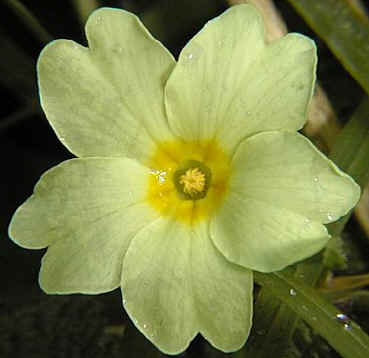Primrose
Primula vulgaris

The Primrose (Primula vulgaris) is native to Britain and Europe. It is a small plant, typically no more than 10 cm (4") high. It produces flowers which generally vary in colour from pale cream to deep yellow. Other colour variants include white and pink flowered forms. Another species related to the Primrose, the Bird's-eye Primrose (Primula farinosa), occurs in moist meadows in northern England. It has pink, purple or occasionally white flowers clustered on the end of a stem. This species favours limestone areas. The Scottish Primrose (Primula scotica) is an endemic British species. It is found only in Orkney, Caithness and Sutherland and in common with the Birds's-eye Primrose, is pink. Other related species are Cowslips (Primula veris) and Oxlips (Primula elatior). Hundreds of other species of Primula exist, mostly concentrated in northern temperate regions of the world. more. Devon, which is in South West England, has an abundance of Primroses. They are very much a part of the distinctive character of the county in spring, forming wonderful displays on the local Devon Hedgebanks. Primroses favour damp places, which abound here in the warmer, wetter climate of the southwest of England. Hedgebanks, woods, road-side verges, railway embankments and churchyards are all good places to look for them. Next time you come across a clump of flowering Primroses, stop and have a closer look. Primroses (and indeed, also many other Primula species) are remarkable in that they have two different types of flowers which look superficially almost identical. One type is called ‘pin-eyed’ and the other, ‘thrum-eyed’. The two different types of flowers are produced on separate plants. |
|
 |
Pin-eyed flower. |
Thrum-eyed flower. |
| The production of two different types of flowers by Primroses, the
pin-eyed and thrum-eyed, is an adaptation to promote cross pollination. The petals of Primroses are joined together at the base to form a tube. Inside this tube are the anthers and style and stigma. (For information on basic flower parts see Flower Structure). In pin-eyed flowers, the stigma is at the top of the flower tube and can be seen in the centre of the flower looking like a small green pin head. In this type of flower, the anthers are in a ring around the style, halfway down the central flower tube. In the thrum-eyed type, the style reaches only halfway up the flower tube, so that the stigma is also positioned halfway up inside the tube. The anthers in this type are located at the top of the flower tube and can be seen as an orange ring in the centre of the flower. Insects visit the flowers in search of nectar, which is located at the bottom of the flower tube. This positioning means that only long-tongued insects can actually reach the nectar in the base. An insect such as a Brimstone butterfly (Gonepteryx rhamni), visiting a pin-eyed flower, gets pollen stuck to the middle of its proboscis from the anthers half-way down the flower tube. If it then goes to visit a thrum-eyed flower, the pollen is perfectly positioned to be wiped off on the stigma, in this case, positioned halfway down the flower tube. The reverse is also true. If the butterfly first visits a thrum-eyed flower, pollen is wiped off onto the top of its proboscis as it searches for nectar. This is then ideally placed to be transferred onto the stigma of the next pin-eyed flower which it visits. more |
